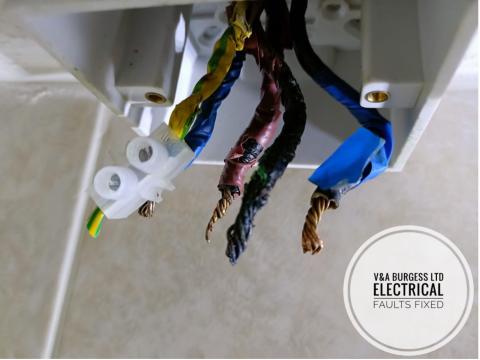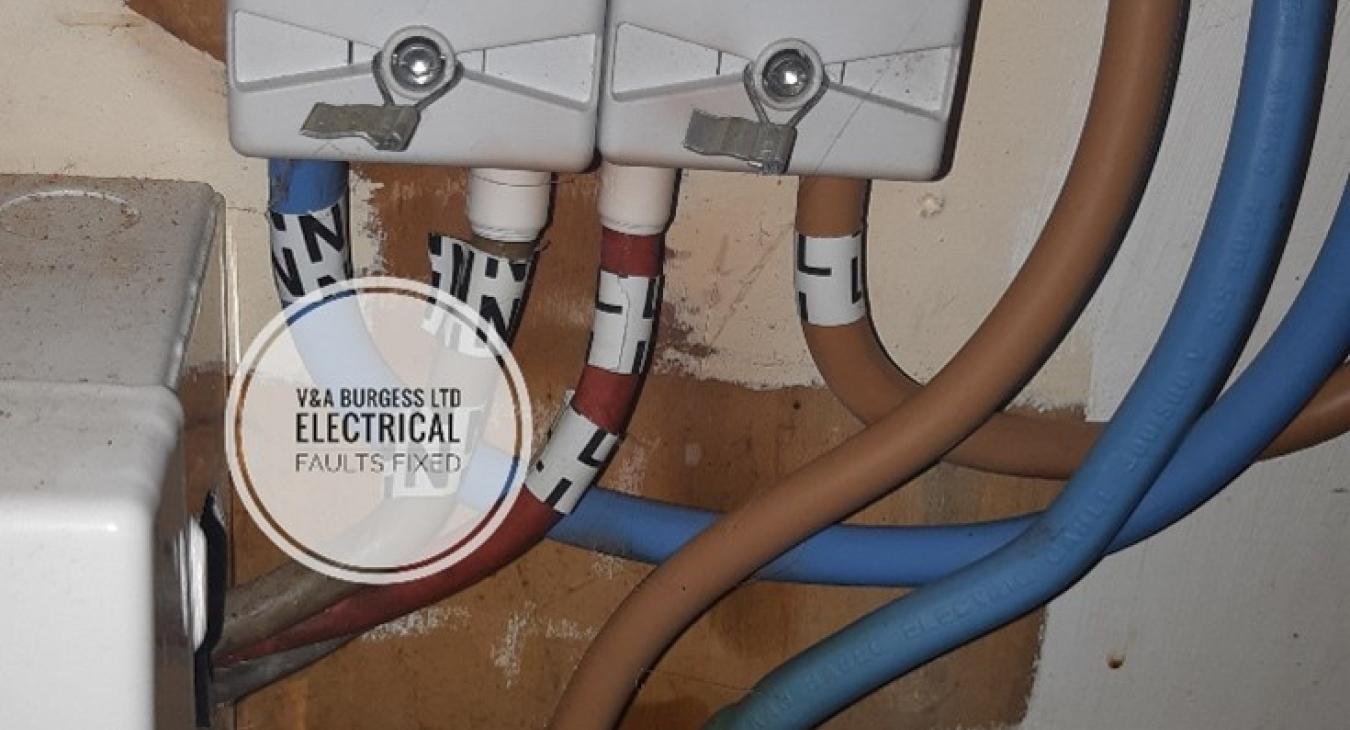
Table of Contents
- Electrical Burning, Causes and Prevention
- What typical situations result in Electrical Burning
- Undersized Cables
- Failing Equipment
- Shorting Out
- Earthing Problems
- Loose Connections
- Poor Quality Accessories
- What about Electric Showers, Cookers, and Car Chargers?
- Fishy Burning Smell Electrics?
- What are other signs of electrical burning?
Updated May 2024
Back to top1) Electrical Burning, Causes and Prevention
ELECTRICAL BURNING in an electrical system is not the intention of the person that designed, constructed, or installed the wiring system.
It is an indication that something serious has occurred. There are a variety of situations that occur and result in electrical burning but generally speaking the result is always:
- Excessive Heat
- High Resistances
- Fire or Melting
If you are experiencing these issues in your wiring system then READ ON to discover WHY, HOW and WHAT has happened!
Back to top2) What typical situations result in Electrical Burning
The photograph is an incoming mains supply cut out which contains the main fuse and shows an emergency situation that we were called to deal with late one night. The issue here was that loose connections had occurred in the incoming supply equipment. (This equipment is dealt with separately and not normally by a general electrician.)
This had resulted in poor electrical conductivity (how easy electrical current can flow through a substance or material) and high heat had been generated due to the increased resistance to current flow.
Typical situations that result in ELECTRICAL BURNING can be:
- Undersized Cables
- Failing Equipment
- Shorting Out
- Earthing Problems
- Poor Installation
- Loose Connections
3) Undersized Cables
During the design of an electrical circuit, the designer will select the correct thickness of electrical cable for the design current of the circuit, the installation method of the cable and the length of run considering voltage drop.
Generally, wiring installations last a really long time when not interfered with.
A cable can become undersized during its lifetime and deviate from the original design of the electrician when things such as, thermal insulation, grouping with other cables, additional equipment and further demand are placed upon the cable.
One of the most common issues in domestic properties is with electric showers. So many people have an electric shower replaced without ever considering if the cable is up to the job of the new MORE POWERFUL shower that they have just installed. The shower will still work but if the electrical current demand exceeds the cable or breaker then overheating is likely to occur along with ELECTRICAL BURNING.
Thermal insulation also seriously affects the ability of an electrical cable to carry its rated current adequately. If a cable is covered, even partially with thermal insulation it can ‘de-rate’ the cable and limit its current carrying ability to HALF of that which it was designed to carry. This is because the cable cannot dissipate its own heat effectively whilst it is covered in thermal insulation.
Be careful insulating your loft or attic space when there are electrical cables present!
Back to top4) Failing Equipment
As equipment is used, ages and experiences wear and tear, various parts can fail internally. Corrosion is a common occurrence on metals which leads to a decrease in surface conductivity and proportionately an increase in resistance to electrical current flow. As this happens, electrical current has difficulty passing from one point to another and as a result, heat is generated leading to copper oxidization which in turn generates an even higher resistance. https://www.ncbi.nlm.nih.gov/pmc/?term=PMC5177874
The situation turns quickly into an ELECTRICAL BURNING certainty as heat and resistance continue to destruction.
Back to top5) Shorting Out
When wires get crossed, equipment malfunctions and accidents happen, electrical shorting out can happen. In an electrical circuit, the electrical current flows down the Line conductor to the electrical equipment, through the resistance of the electrical equipment and out down the Neutral Conductor.
When Line touches Neutral directly, this is known as ‘shorting out’. No resistance is experienced between Line and Neutral as would be expected to limit the amount of electrical current that flows. Without this resistance a MASSIVE fault current occurs, far beyond the capabilities of the electrical systems handling capabilities and as a result ELECTRICAL BURNING can occur.
Back to top6) Earthing Problems
When there are earthing problems such as undersized earthing conductors, this can result in the cable overheating or catching fire before the electrical supply is able to shut off. Large fault currents can occur if the earth resistance is too high.
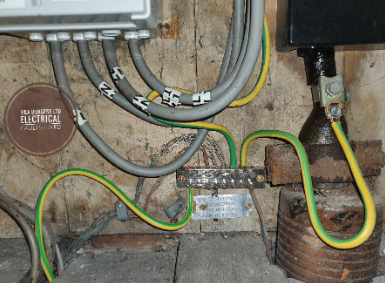
(Earthing Wires in an Electrical Installation)
Back to top7) Loose Connections
The issue of loose connections is a common one in electrical installations and especially in domestic installations. There are several reasons why connections may become loose which can all join together to exacerbate the problem:
- Poor Installation
- Incorrect Torque applied
- Expansion and Contraction of Differing Metals
- Vibration on Supply Frequency
- Poor Quality Accessories
7.1) Poor Installation
When electrical equipment is installed poorly, without the correct knowledge, tools, and equipment, it can quickly cause issues to occur in the wiring system. Cables should be neatly and carefully installed leaving enough room for the replacement of future accessories but not such that connections can become trapped or so that cables can become crushed behind electrical accessories.
Mechanical strain on cables can cause strain on the cable terminations where they meet the back of shower switches, plug sockets and other electrical accessories. This strain along with other factors will result in inevitable electrical burning in the future along with shortening the life of the cable and wiring accessories.
Cables that are most at risk of poor installation tend to be the larger, thicker, and more difficult to deal with type cables as it takes the right experience to know how to work with these cables easily without causing damage or leaving a poor job.
Thicker cables tend to power our showers, cookers and car chargers, the exact electrical equipment that we would want to be the safest!
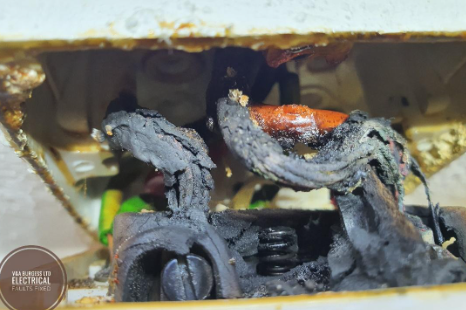
(The Back Terminals of a Shower Pull Cord Isolator Ruined!!)
7.2) Incorrect Torque Applied
Every manufacturer of electrical equipment, and in particular consumer units or electrical panels, will have a requirement for specific ‘tightness’ or torque that should be applied to their equipment’s electrical terminals.
This level of torque is impossible to achieve exactly without the correct equipment. Many electricians still tighten by ‘feel’ which is fine in many situations. With decades of experience, I imagine that most electricians could fairly accurately torque equipment to near enough its requirements.
The best method for achieving the correct torque on electrical terminals is to use a correctly designed torque screwdriver for this very purpose. The screwdriver will let you know when there is the correct amount of torque that has been applied and then you can be sure that the cables are tight enough in the terminals. This does not negate the need for a ‘tug test’ to ensure that whilst the terminal may be tight that the cable has actually caught correctly in the terminal.
I find that the WIHA 38074 is particularly good and is in daily use in my toolkit.
https://wihadirect.co.uk/products/torquevario%C2%AE-s-screwdriver-set-0-8-5-0nm-38074
7.3) Expansion and Contraction of Different Metals
Electrical cable tends to be manufactured from copper due to its relatively low cost – conductivity ratio along with its ease of installation and longevity.
Electrical terminals are often comprised of Brass, Nickel and Steel metals which are more suited to the stresses to withstanding screwdriver torque and other shearing forces.
These different metals all behave differently with temperature in their rate of expansion and contraction. This varying and continued expansion and contraction of metals when the electrical system is used under normal conditions will cause the connections between cable and terminals to loosen very slightly over time.
This loosening of terminal connections leads to an increase in resistance in the terminal connections as contact area is reduced. With higher resistance to current flow comes a higher temperature and so burning eventually occurs, especially in electrical circuits with high current demand.
7.4) Vibration on Supply Frequency
The electrical supply that powers our homes is in the form of AC or Alternating Current. This means that the electrical supply reverses its direction and polarity regularly and quickly in accordance with the frequency of generation. In the UK this occurs 50 times per second. Northern America its 60 times per second. Or 50Hz and 60Hz respectively.
This constant changing in current magnitude and direction leads to a very tiny, imperceptible vibration which can also contribute to the loosening of connections in combination with the expansion and contraction of the differing metals.
Back to top8) Poor Quality Accessories
In every industry, in every area of retail and life there is the opportunity to ALWAYS PAY LESS. This comes at a cost in all cases and the usual price you pay for lower cost is poorer quality and workmanship.
Every electrical accessory manufactured and produced will comply with the relevant British Standard OR equivalent in your territory. The issue is, these are MINIMUM standards and as such, the MINIMUM will be done to meet these standards with poorer quality accessories.
There are clear and obvious differences between manufacturers and their ranges of equipment in material and construction quality. Electrical components and accessories are generally not an area to skimp on but the expected use of the product should be considered.
Cheap electrical terminals often contain screws that round off and terminals that don’t hold conductors easily the first time they are tightened. Cheap plug sockets can also contain thinner earthing bars and thinner plastics involved in the manufacturing process. This cost saving measure is not dangerous but may mean that the accessories won’t withstand the same wear and tear of more expensive accessories and break down sooner.
Back to top9) What about Electric Showers, Cookers, and Car Chargers?
We often see electric burning taking place in shower circuits. The shower pull cord can become an issue and is often the site of electric burning beginning to take place. A lot of electrical current passes through a shower circuit and pull cords can become a weak point.
Electric Cookers and Car chargers are also more susceptible to developing loose connections due to the relatively large power draw on these circuits over a period of time.
Back to top10) Fishy Burning Smell Electrics?
If you can smell a fishy, chemical smell it could be ELECTRICAL BURNING. If you can see electric burning taking place or suspect that there may be issues in your property like this then it’s best to call an electrician immediately.
Common problems that involve electric burning can occur in the consumer unit. Various issues with consumer units mean that things can often go wrong. Mismatched circuit breakers, that is, circuit breakers that are different brands can cause serious issues sometimes.
If your consumer unit has circuit breakers that are different brands or that appear to fit differently than the other inside the consumer unit then it’s best to have them checked out. These differing brands can sometimes cause problems with mechanical strain, heat dissipation and the alignment of the front cover of the unit potentially leaving dangerous gaps.
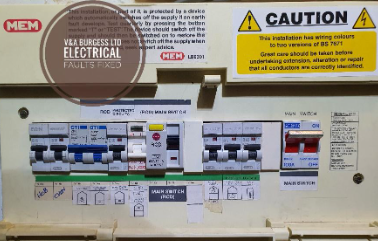
(Mismatched Circuit Breakers from Different Brands in Electrical Panel)
Back to top11) What are other signs of electrical burning?
Flickering lights, intermittent operation of appliances and sockets and so on can be a symptom of electrical burning possibly taking place somewhere.
Whatever your concerns or issues, we are here to help. You can contact us through our contact form, WhatsApp, or give us a call.


